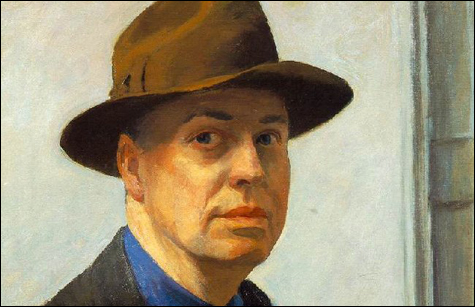
SELF-PORTRAIT: The MFA’s “Edward Hopper” brought together many of the painter’s lonely film
noir masterpieces. |
A Salem museum raised the stakes, the Museum of Fine Arts did big things with Napoleon and Edward Hopper, pictures of prostitutes graced the walls of Boston’s two biggest art museums, and all hell broke loose when the Mooninites invaded. It’s the best art of 2007, as seen by Jeffrey Gantz, Christopher Millis, David Eisen, and myself.
Champion boxer
“Joseph Cornell: Navigating the Imagination” at Salem’s Peabody Essex Museum was a thrilling surprise from a museum best known for focusing on New England, the cultures Salem touched via the China trade, and Native American life. Lynda Roscoe Hartigan, a Cornell expert who came to the museum from the Smithsonian in 2003, assembled the best blockbuster exhibit in the region this year, a breathtaking, comprehensive, once-in-a-generation retrospective of Cornell’s dreamy shadow boxes. Is it a sign of what to expect from the Peabody Essex in the future? “It really is about signaling,” Hartigan tells me, “in as direct way as we could think of, that we mean business about doing work in the modern- and contemporary-art arena.” Another signal: plans to hire curators of photography and contemporary art in 2008.
Breakout performance
Bostonian Andrew Mowbray’s show “Bathyscape” at Space Other gallery this spring presented a video (exhibited with exquisitely crafted props) in which he climbed into an Art Nouveau diving bell, shaved off his hair, tied the locks into fishing lures, and framed them. Mowbray let the mysteries stew, and the gorgeous strangeness seeped under your skin. Another highlight of Space Other’s year was Erik Levine’s haunting, horrifying “More Man” video, which studied high-school football to plumb rituals of American manhood.
Best “art” mistaken for terrorist attack
January’s Mooninites invasion. We’re still thanking our lucky stars that we survived its Lite-Brite-style corporate advertisements colonizing public and private property without permission, the shutdown of Route 93, the bomb-squad heroics, the arrests, the “hairstyles in the ’70s” press conference, and the $2 million corporate apology. Runner-up: September’s arrest at gunpoint at Logan Airport of an MIT student sporting a button that featured harmless LED lights, a circuit board, and a nine-volt battery.
The establishment
The Museum of Fine Arts repeatedly, splendidly demonstrated why its arts are so fine. "Edward Hopper” brought together many of the painter’s lonely film noir masterpieces. The museum drew exclusively from its own collection of ukiyo-e paintings of performers, escorts, and high-end prostitutes for the terrific “Drama and Desire: Japanese Paintings from the Floating World, 1690–1850.” And “Symbols of Power: Napoleon and the Art of Empire Style, 1800–1815,” on view through January 27, is a magnificent survey of the French style of design — by turns spare and opulent, revolutionary and imperial — that spread across Europe during the reign of the great dictator.
Major leaguers
“Philip-Lorca diCorcia," at the Institute for Contemporary Art, was a handsome, smart, thorough mid-career survey of a major American postmodern photographer. The best part: moody, lovely Hustler photos of real prostitutes posed in manufactured set-ups. It looked like a documentary about prostitutes; in fact it was a documentary about Hollywood myths of prostitutes. For “Archive,” at Barbara Krakow Gallery, Jenny Holzer took declassified government documents from the “War on Terror” and reproduced them straight-up in screenprints, blacked-out passages and all. The texts — especially the testimony of prisoner abuse — were a devastating, and depressing, indictment of the callousness and carelessness of the Bushies.